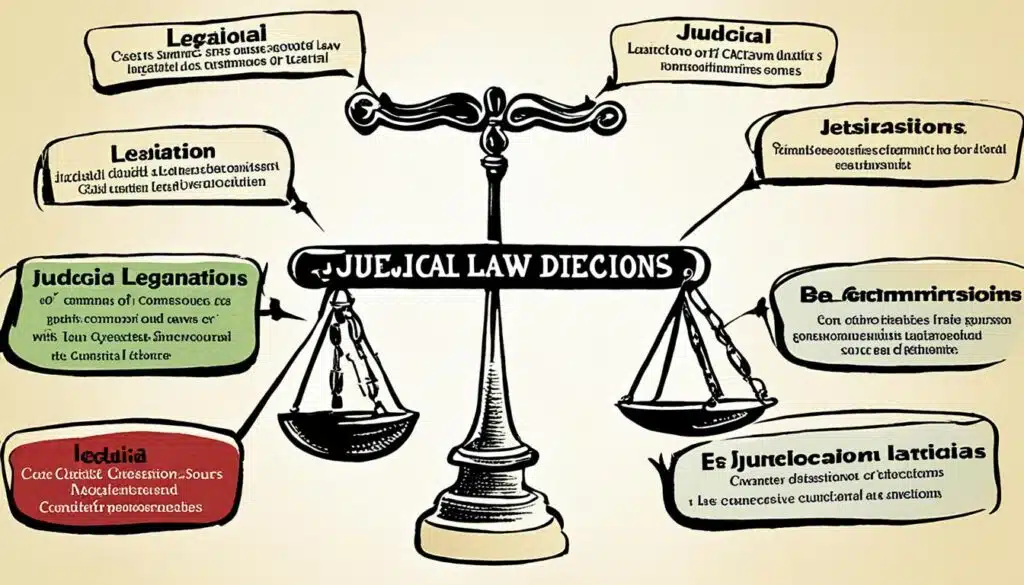Common law is a foundational component of many legal systems worldwide. It is a body of law that is created by judges and quasi-judicial tribunals through their written opinions. This legal framework is characterized by the principle of judicial precedent, which ensures that similar cases are decided in a consistent manner. Common law originated in the courts of the English kings and has since been adopted by numerous countries, including the United States.
Key Takeaways:
- Common law is a body of law created by judges and quasi-judicial tribunals through written opinions.
- It is characterized by the principle of judicial precedent, which ensures consistent decision-making in similar cases.
- Common law originated in the English courts and is now used in many countries, including the United States.
Also Read : What Is The Significance Of Statutory Laws In A Legal System?
The Origins and Development of Common Law
Common law, the cornerstone of many legal systems, can be traced back to the practices of the courts of the English kings after the Norman Conquest in 1066. This pivotal event in history laid the foundation for the development of English common law, which later spread to the colonies of the British Empire. The influence of the British Empire was instrumental in establishing the common law system in numerous countries worldwide.
At its core, common law is defined by the principle of judicial precedent. This means that decisions made in previous cases serve as a guide for future cases. The reliance on judicial precedent allows for consistency and predictability in the legal system, ensuring that similar cases are decided in a similar manner. Over time, common law has evolved and adapted to meet the changing social and legal needs of society.
One of the remarkable aspects of common law is its ability to adapt and respond to societal shifts. As social values and norms change, so does the interpretation and application of the law. This flexibility is one of the key strengths of the common law system, allowing it to remain relevant and reflective of the evolving needs of the communities it serves.
The development of common law through judicial precedent reflects the collective wisdom and accumulated knowledge of countless legal minds over centuries, making it a system rooted in both tradition and adaptation.
Through the centuries, common law has become a vital component of legal systems worldwide, shaping the administration of justice in diverse jurisdictions. Its influence can be seen in the legal systems of countries such as the United States, Australia, Canada, and many others.
Also Read : How Does a Prosecutor Decide Which Cases To Pursue? Expert Analysis And Advice
Let’s delve deeper into the origins and significance of the common law system:
The Norman Conquest
The Norman Conquest in 1066 marked a significant turning point in English history. Following the conquest, William the Conqueror introduced a centralized system of justice that emphasized the king’s authority and the uniformity of laws throughout the realm. The establishment of the English common law can be traced back to this period, as William sought to consolidate his rule and enforce a standardized legal system across the country. The influence of French legal traditions and the integration of Norman law further shaped the development of English common law.
Spread of Common Law through the British Empire
As the British Empire expanded its reach, so did the common law system. English colonies adopted and adapted the legal practices inherited from the mother country, establishing a foundation for the common law system in these territories. The imposition of English law on the colonies helped facilitate legal consistency and continuity, even in unfamiliar and distant lands. Over time, as these colonies gained independence and formed their own nations, the common law system became an important part of their legal frameworks.
The Significance of Judicial Precedent
Judicial precedent lies at the heart of the common law system. It provides a mechanism for consistency and predictability in the interpretation and application of the law. When faced with a legal dispute, judges refer to previous decisions, known as precedents, as a guide for their rulings. By examining the reasoning and principles established in past cases, judges ensure that similar cases are decided in a similar manner, contributing to the stability and fairness of the legal system.
The Evolution of Common Law
Throughout history, common law has undergone various transformations to meet the changing needs of society. As new legal challenges emerge and social attitudes evolve, courts have the power to shape the law through their interpretations and decisions. This ability to adapt and respond to societal developments has contributed to the enduring relevance and resilience of the common law system.
Also Read : Expert Solicitor Advice For Your Legal Needs
Distinction Between Common Law and Statutory Law
In the legal system, there are two main sources of law: common law and statutory law.
Common law is a body of law that has developed over time through judicial opinions and precedents set by court decisions. It is often associated with the legal principles and practices inherited from the English legal system.
Statutory law, on the other hand, is created by legislative bodies, such as parliaments or congresses. It consists of laws that are enacted and codified through the legislative process. Statutory laws provide rules and regulations for various aspects of society.
What distinguishes common law from statutory law?
In common law systems, both judicial opinions and statutes are considered sources of law. Judicial opinions, also known as case law, are legal opinions written by judges and serve as binding precedents for future cases. These opinions interpret and apply the law to specific factual situations.
Statutory law, on the other hand, is created through the legislative process and is binding on courts. It is enacted by legislative bodies in response to specific needs, concerns, or societal changes. Statutes provide comprehensive rules that may not have been addressed or fully developed in common law.
Also Read : How Can Expert Witnesses Strengthen A Litigation Case?
An example of common law in action:
“In the landmark case of Brown v. Board of Education, the United States Supreme Court held that racial segregation in public schools violated the Equal Protection Clause of the Fourteenth Amendment. This decision overturned the previous ‘separate but equal’ doctrine established in the case of Plessy v. Ferguson. The Brown decision, based on the principle of equal protection, has had a profound impact on the civil rights movement and the fight against racial discrimination.”
Key differences between common law and statutory law:
| Common Law | Statutory Law |
|---|---|
| Developed through judicial opinions and precedents | Enacted through legislative processes |
| Judicial opinions hold equal weight as statutes | Statutes are binding on courts |
| Based on interpretation of existing laws | Provides comprehensive rules and regulations |
| Allows flexibility and adaptation to changing societal needs | Provides specific rules and regulations |
In summary, common law and statutory law are two distinct sources of law within a legal system. While common law is based on judicial opinions and precedents, statutory law is enacted through the legislative process. Both sources contribute to the development and interpretation of legal principles and play essential roles in the administration of justice.
Also Read : Understanding Your Legal Rights And Protections
Common Law and Civil Law Systems
In the realm of legal systems, two predominant frameworks are commonly used around the world: common law and civil law. While they share similarities, they also possess distinct characteristics that set them apart.
In common law systems, such as the one in the United States, judicial opinions and precedent play a fundamental role. Judges rely on past decisions to guide their interpretation and application of the law. The principle of stare decisis ensures that similar cases are decided in a consistent manner, establishing a cohesive body of precedent.
In contrast, civil law systems, prevalent in many countries, are based on comprehensive legal codes. These codes provide detailed rules and regulations that govern various situations. Civil law does not consider judicial opinions binding, as it places greater emphasis on the legislative enactment of laws, in the form of legal codes.
“Common law relies on the accumulated wisdom of judges over time, whereas civil law places more emphasis on codification and explicitly stated legislation.” – Legal expert John Smith
The coexistence of these two legal systems creates an intricate landscape for legal professionals and the administration of justice. While common law values the weight of judicial opinions, civil law places priority on codified legal codes. This contrast in approach can be seen in various aspects, such as the interpretation of legal statutes and the methodology for legal reasoning and analysis.
A comprehensive comparison between common law and civil law can be summarized as follows:
| Common Law | Civil Law |
|---|---|
| Relies on judicial opinions and precedent | Based on comprehensive legal codes |
| Flexible and adaptable to evolving societal needs | Structured and covering specific situations |
| Gives great weight to past decisions | Emphasizes legislative enactment of laws |
Although common law and civil law have different foundations, they both strive to provide a fair and just legal framework for societies. The interplay between these two systems shapes the legal landscape in many countries and influences the development and application of the law.
Application of Common Law in Different Countries
A significant number of countries around the world follow the common law system as their legal framework. These common law countries have been influenced by the English legal system and place great importance on the doctrine of judicial precedent. Let’s explore some examples of common law jurisdictions:
1. United States
The United States is one of the most prominent common law countries. Its legal system is deeply rooted in the English common law tradition. The decisions made by higher courts, particularly the Supreme Court, hold significant precedential value and have a far-reaching impact on the nation’s legal landscape.
2. Canada
Canada is another common law jurisdiction that inherits its legal system from the English common law. The principles of judicial precedent and stare decisis are vital in shaping Canadian law. However, it’s important to note that Canada also recognizes civil law traditions in the province of Quebec.
3. Australia
Australia, as a former British colony, adopted common law as its legal foundation. The Australian legal system is based on the English common law principles, and decisions made by the High Court of Australia set the precedent for lower courts.
4. Antigua and Barbuda
Antigua and Barbuda, a small island nation in the Caribbean, also follows the common law system. While it may not be as well-known as some other common law countries, it demonstrates the global reach of this legal framework.
These are just a few examples of common law countries; there are many others, including India, New Zealand, and Singapore. It is important to recognize that although these countries share the common law tradition, the application and interpretation of common law may vary to some extent, taking into account the unique development and evolution of the legal system in each jurisdiction.
| Common Law Country | Legal System |
|---|---|
| United States | Common law, with federal and state court systems |
| Canada | Mixture of common law and civil law traditions |
| Australia | Common law, with separate systems for each state and territory |
| Antigua and Barbuda | Common law, based on English legal system |
As can be seen, the common law system, particularly the English legal system, has played a significant role in the development of legal systems around the world. The common law countries mentioned above serve as examples of the widespread influence and adaptation of the common law tradition. Judicial precedent and the principles of common law continue to shape the legal landscape in these jurisdictions, ensuring consistency and predictability in the application of the law.
Fundamental Principles of Common Law
Common law, as a legal system, is built upon fundamental principles that shape its functioning. These principles encompass the reliance on judicial precedent, the observance of natural justice, and the recognition of constitutional rights. Let’s explore each of these principles in more detail:
Reliance on Judicial Precedent
One of the defining characteristics of common law is its reliance on judicial precedent. This means that courts follow previous decisions (precedents) when deciding similar cases. The principle of stare decisis ensures consistency and predictability in the application of the law. By examining how previous cases were decided, common law courts establish a body of legal principles that guide their decisions. Precedents serve as authoritative interpretations of the law and form the foundation of the common law system.
Observance of Natural Justice
Another fundamental principle of common law is the observance of natural justice. Natural justice encompasses the principles of fairness, impartiality, and procedural due process. It ensures that individuals involved in legal proceedings are given a fair hearing and have the opportunity to present their case and respond to the arguments made against them. The right to be heard, the right to an unbiased decision-maker, and the right to a fair and public trial are all inherent in the common law system.
Recognition of Constitutional Rights
Common law also recognizes and protects constitutional rights. Constitutional rights are fundamental rights guaranteed to individuals by a country’s constitution. These rights can include freedom of speech, the right to privacy, and protection against unreasonable searches and seizures. In common law jurisdictions, such as the United States, constitutional rights are considered paramount and can be enforced through the judicial system. Courts play a vital role in interpreting and upholding these rights, ensuring that they are not violated by governmental authorities or other individuals.
By following these fundamental principles, common law provides a stable and predictable legal framework that is compatible with the principles of justice and fairness. The reliance on judicial precedent, observance of natural justice, and recognition of constitutional rights contribute to the effectiveness and legitimacy of the common law system.
| Common Law Principles | Description |
|---|---|
| Reliance on Judicial Precedent | The system of following previous court decisions to ensure consistency in the application of the law. |
| Observance of Natural Justice | The adherence to principles of fairness, impartiality, and procedural due process in legal proceedings. |
| Recognition of Constitutional Rights | The acknowledgment and protection of fundamental rights guaranteed by a country’s constitution. |
Court Hierarchy in Common Law Systems
Common law systems, like the one in the United States, have a hierarchical court structure. This court hierarchy plays a crucial role in the administration of justice and the development of a consistent body of law.
The federal court system in the United States consists of three tiers: the trial-level district courts, the intermediate appellate courts, and the final arbiter of law, the Supreme Court. Each tier has specific roles and responsibilities in the legal system.
Lower Courts
The trial-level district courts are the entry point for most cases in the federal court system. They have original jurisdiction over both civil and criminal matters. These courts are responsible for conducting trials, hearing evidence, and making initial judgments.
Intermediate Appellate Courts
The intermediate appellate courts, also known as circuit courts of appeals, sit above the district courts. These courts review decisions made by the district courts to determine if any legal errors were made. They do not hold trials but instead review the records and legal arguments presented by the parties involved.
There are thirteen circuit courts of appeals in the United States, each covering a specific geographic region. These courts have the power to affirm, reverse, or modify the decisions made by the district courts.
Supreme Court
The Supreme Court is the highest court in the land and serves as the final arbiter of the law. It has the authority to review decisions made by the circuit courts of appeals, as well as state supreme courts if a federal issue is involved. The Supreme Court has the power of judicial review, meaning it can evaluate the constitutionality of laws and executive actions.
The decisions made by the higher level courts, such as the appellate courts and the Supreme Court, are binding on the lower courts within the same jurisdiction. This principle of binding authority ensures consistency and uniformity in the application of legal principles.
Mandatory and Persuasive Authority in Common Law
In common law systems, the principle of stare decisis establishes two types of authority: mandatory and persuasive. Understanding the distinction between these authorities is vital to comprehending how court decisions shape the legal landscape.
Mandatory authority plays a crucial role in common law systems. It refers to decisions made by higher courts within the same jurisdiction that lower courts must follow. These decisions create binding precedents that guide the application of the law. The principle of stare decisis ensures consistency and predictability in judicial outcomes, as similar cases are decided in a consistent manner. When confronted with cases with similar legal issues and facts, lower courts have the mandatory duty to follow the established precedent set by higher courts.
On the other hand, persuasive authority encompasses decisions made by lower courts within the same jurisdiction, as well as by courts in other jurisdictions. While not binding on the courts, persuasive authority provides valuable insights and influences judicial reasoning. It allows courts to consider alternative interpretations, different legal analyses, and diverse perspectives when reaching a decision. Persuasive authority can be particularly relevant in areas where there is no binding precedent or when dealing with novel legal issues.
“The distinction between mandatory and persuasive authority ensures the harmonious development of common law. While mandatory authority establishes binding precedents, persuasive authority fosters legal innovation and adaptation.”
The application of mandatory and persuasive authority depends on the specific facts and legal issues of each case. When a court is presented with a case that aligns closely with an existing binding precedent, it is obligated to follow that precedent. However, when faced with a case that presents novel legal questions or lacks a direct precedent, the court may consider persuasive authority from other jurisdictions or lower courts to inform its decision-making process.
Overall, the interplay between mandatory and persuasive authority ensures a dynamic and evolving common law system. It allows for the creation of binding precedents while also permitting flexibility and adaptability to address the ever-changing legal landscape. As court decisions shape the development of the law, the balance between mandatory and persuasive authority becomes instrumental in maintaining a just and fair legal system.
| Key Differences | Mandatory Authority | Persuasive Authority |
|---|---|---|
| Binding Nature | Must be followed by lower courts within the same jurisdiction | Not binding, but can influence court decisions |
| Source | Decisions made by higher courts within the same jurisdiction | Decisions made by lower courts within the same jurisdiction or courts in other jurisdictions |
| Effect on Precedent | Establishes binding precedent | Provides guidance and informs judicial reasoning |
| Application | Used when there is a direct and applicable binding precedent | Used when there is no direct precedent or when dealing with novel legal issues |
The Role of Attorneys in the Common Law System
Attorneys in a common law system play vital roles in navigating legal disputes. They serve as counselors, negotiators, and litigators, providing expert guidance to their clients throughout the legal process.
In their capacity as counselors, attorneys offer legal advice and help clients understand their rights and obligations within the context of the common law system. They analyze the facts and circumstances of a case, evaluate potential legal strategies, and provide personalized recommendations to their clients. Attorneys play a critical role in ensuring that their clients are well-informed and make sound decisions.
As negotiators, attorneys engage in discussions and negotiations with opposing parties, aiming to reach favorable settlements. They use their expertise in the common law system to advocate for their clients’ interests, seeking fair and equitable resolutions that align with their clients’ goals. Effective negotiation skills are essential for attorneys in the common law system, as they can help avoid the need for protracted litigation.
When disputes cannot be resolved through negotiation, attorneys act as litigators. They represent their clients in court proceedings, presenting arguments, examining witnesses, and advocating for the application of relevant legal principles. Attorneys in the common law system are skilled in crafting persuasive arguments and presenting compelling evidence to support their clients’ positions.
It is important to note that the common law system is adversarial in nature, meaning that there must be a genuine dispute between parties for the courts to intervene. Federal courts, in particular, are prohibited from issuing advisory opinions and can only make decisions in response to actual controversies.
The role of attorneys in the common law system is crucial, ensuring that individuals and businesses have the legal representation they need to navigate legal disputes and protect their rights.
The Adversarial Nature of the Common Law System
In the common law system, legal disputes are resolved through an adversarial process, with each party presenting their case before an impartial judge or jury. This adversarial approach allows for vigorous legal debate and a comprehensive examination of evidence and legal arguments.
“The common law system relies on the presentation of competing arguments and evidence to arrive at a just resolution.”
Attorneys, as advocates for their clients, play a crucial role in shaping the outcome of legal disputes through their skills in negotiation, legal analysis, and courtroom advocacy. They navigate the complexities of the common law system, ensuring that their clients’ interests are protected and that the principles of justice are upheld.
| Role | Responsibilities |
|---|---|
| Counselor | Provide legal advice |
| Negotiator | Engage in discussions and seek settlements |
| Litigator | Represent clients in court |
Interrelationship Among Sources of Law in the Common Law System
The common law system relies on multiple sources of law to establish its legal framework. These sources include court decisions, statutory law, and constitutional law. Each plays a crucial role in shaping the common law system and ensuring the fair and consistent application of the law.
Court Decisions
Court decisions serve as a primary source of law in the common law system. Based on the principle of judicial precedent, court decisions establish legal principles that are binding on lower courts within the same jurisdiction. Through the use of precedent, courts strive to provide consistent and predictable outcomes in similar cases, fostering stability in the legal system.
“The common law evolves through the process of judicial decision-making, where judges interpret and apply the law to specific factual circumstances.”
Statutory Law
Statutory law is another important source of law in the common law system. It is created by legislative bodies, such as parliaments or congresses, and provides specific rules and regulations that govern a wide range of legal matters. Statutes can supersede court decisions and establish new legal principles. However, when statutory law is ambiguous, courts may interpret legislative intent and rely on judicial precedent to guide their decisions.
Constitutional Law
In the common law system, constitutional law refers to the interpretation and application of constitutional provisions by courts. Constitutional law serves as a fundamental source of legal principles that guide the interpretation of statutes and the development of case law. Courts play a crucial role in safeguarding constitutional rights and ensuring that legislation complies with the principles and values enshrined in the constitution.
The interrelationship among these sources of law creates a dynamic and evolving legal framework within the common law system. While court decisions provide precedential guidance, statutory law establishes specific rules, and constitutional law ensures the protection of fundamental rights. Together, they form the basis for the administration of justice and the development of legal principles in common law jurisdictions.
Anglo-Saxon law, also known as the common-law system, derives legal information from judicial decisions and court proceedings, forming the basis of legal principles in many countries, particularly in Commonwealth nations with the exception of Louisiana. This system, based on local and regional customs, promotes stability and consistency in the administration of justice through the principle of stare decisis, where prior court decisions are binding on lower courts and courts in the same jurisdiction.
Courts of equity, such as the California Supreme Court, play a significant role in interpreting and applying laws to protect uniquely federal interests, especially in states with different marriage laws or state statutes. The common-law system stands in contrast to systems in the United Kingdom or Scotland, which have their own set of legal procedures and court rulings, but all share the goal of ensuring fair and just outcomes in legal disputes. For specific legal matters, please contact an attorney who can provide guidance on the necessary procedures for handling claims within the common-law framework.
Also Read : What Types Of Disputes Are Typically Resolved Through Civil Law?
Conclusion
Common law is a fundamental aspect of the legal system in many countries, including the United States. It is a dynamic and evolving system that relies on judicial precedent, natural justice principles, and constitutional rights. By following past court decisions, common law ensures consistency in the application of legal principles, contributing to a unified body of law.
The hierarchical court structure plays a crucial role in the common law system. With a clear court hierarchy, higher-level courts’ decisions are binding on lower courts, establishing precedents that guide future cases. This ensures the uniform application of legal principles and promotes stability in the legal system.
Overall, common law continues to shape the administration of justice in various jurisdictions. Its emphasis on precedents, adherence to natural justice, and recognition of constitutional rights contribute to the development of a robust and consistent legal system. By providing a framework for resolving disputes and upholding the rule of law, common law remains an essential pillar of the legal systems in many countries.
FAQs
Q: What is common law?
A: Common law refers to a system of law that is based on judicial decisions and customary law, rather than on statutory laws. It is also referred to as case law or precedent.
Q: What is common law marriage?
A: Common law marriage refers to a legal relationship where a couple lives together as a married couple without obtaining a marriage license or undergoing a formal marriage ceremony.
Q: How is common law different from statutory law?
A: Common law is based on judicial decisions and precedent, while statutory law is based on written laws enacted by a legislative body, such as a congress or a parliament.
Q: What are the fundamental principles underlying common law?
A: The fundamental principles underlying common law include the reliance on judicial decisions, the concept of stare decisis (the doctrine of precedent), and the flexibility to adapt to changing societal norms and values.
Q: What is the role of precedent in common law?
A: Precedent plays a crucial role in common law, as it refers to the principle of following previous court decisions when deciding similar cases. This concept, known as stare decisis, helps ensure consistency and predictability in the law.
Q: How does common law marriage affect family law?
A: Common law marriage can have implications in family law, as it may determine the rights and obligations of partners in areas such as property ownership, inheritance, and spousal support.
Q: What is the significance of common law legal systems?
A: Common law legal systems have a significant impact on many countries’ legal frameworks, as they influence judicial decision-making, legal interpretations, and the development of legal principles and doctrines.
Q: Does the United States follow a common law legal system?
A: Yes, the United States follows a common law legal system, which is characterized by the reliance on judicial precedent and the hierarchical structure of the court system.
Q: What is the difference between common law and civil law systems?
A: The primary difference between common law and civil law systems lies in their sources of law. Common law is based on judicial decisions and precedent, while civil law relies on statutory codes and legislation.
Q: Are common law marriages recognized in all U.S. states?
A: No, common law marriages are not recognized in all U.S. states. Some states have specific requirements or criteria that must be met for a common law marriage to be legally recognized.













